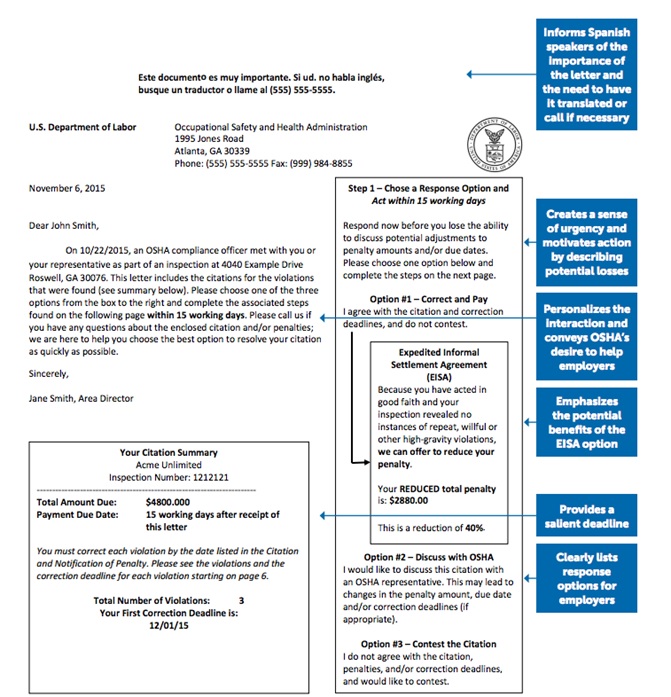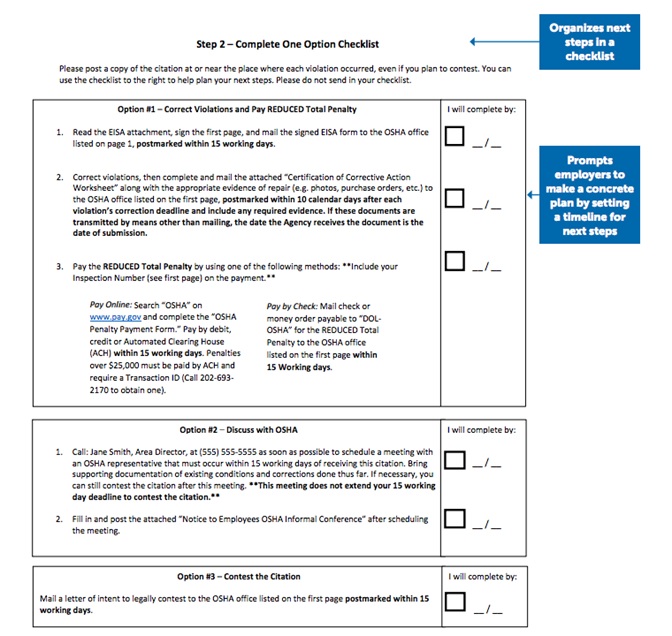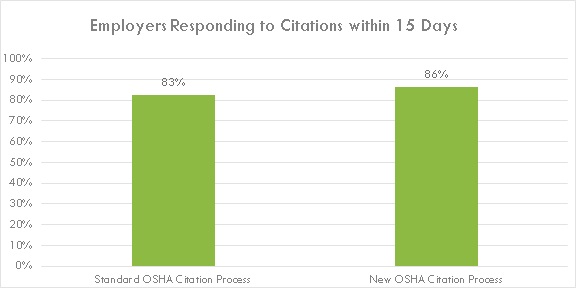
“Please Respond:” Redesigning Safety Violation Citations
Organization : ideas42
Project Overview
Project Summary
Researchers redesigned several components to citing companies for violating workplace safety regulations. The redesign included (1) a handout previewing the citation process, (2) a redesigned, informative cover letter, and (3) reminders postcards and phone calls to prompt responses.
Impact
Employers were 3.9 percentage points more likely to respond to the citation, with 86.4% either signing a settlement, paying a fine, or contesting their citation, compared to 82.5% of employers under the standard citation process.
Source
Source
Challenge
In 2013, the Occupational Safety and Health Administration (OSHA) issued 25,000 citations for workplace safety violations. Of these, 22% were referred to its national office for non-payment. In 75% of referred cases, employers had never responded to the citation.
Employers are typically granted 15 days to accept or contest OSHA citations. Those who accept it must agree to resolve the cited hazards and pay a penalty, which can be negotiated with OSHA representatives. Failing to comply with this process can have legal implications for employers.
Design
The standard process for issuing citations involves a written citation package that contains an explanation of the violations, the corrections that are required, any fines being imposed, and the employer’s options for responding.
A group of employers implemented a redesigned OSHA citation process that made three changes to the standard procedure. The aim was to remove behavioral barriers to a timely response, such as misunderstanding the citation or simply forgetting to respond. The changes included:
1. Previewing the citation process: Walking through a new handout with employers during the initial inspection, explaining what employers can expect and what their response options are if they receive a citation.
2. Improvements to the cover letter: Developing a clearer, more informative cover letter, including a concise explanation of the employer’s response options and emphasizing the importance of prompt action.
3. Providing timely reminders: Sending postcards and making follow-up telephone calls to employers about their response options and critical deadlines.

First page of the redesigned citation letter

Second page of the redesigned citation letter
Impact

A randomized evaluation found that the new citation process prompted more employers to engage with OSHA, whether that means signing an informal settlement, paying at least some of their fines, or formally contesting their citation. In the new citation process, 86.4% of employers engaged compared to 82.5% of employers under the standard procedure – a 3.9 percentage point difference.
In which areas of engagement were there the greatest increases? Employers following the new citation process were 6.3 percentage points more likely to sign an informal settlement agreement than employers following standard processes (72.7% vs. 66.4%) and 2.8 percentage points more likely to make a payment toward the penalties they owed (75.9% vs. 73.1%).
A second phase of the study implemented a simpler intervention that removed some of the most expensive and time-intensive components such as the phone call reminders. The results of the second phase of the study will be added when available.
Implementation Guidelines
Inspired to implement this design in your own work? Here are some things to think about before you get started:
- Are the behavioral drivers to the problem you are trying to solve similar to the ones described in the challenge section of this project?
- Is it feasible to adapt the design to address your problem?
- Could there be structural barriers at play that might keep the design from having the desired effect?
- Finally, we encourage you to make sure you monitor, test and take steps to iterate on designs often when either adapting them to a new context or scaling up to make sure they’re effective.
Additionally, consider the following insights from the design’s researcher:
- Present actionable next steps clearly and prominently. Including prompts for letter recipients to create plans to complete next steps can be one way of increasing salience.
- Create urgency surrounding the deadline to reduce procrastination. In this case, the OSHA letter included consequences of non-action.
Project Credits
Researchers:
Greg Chojnacki Mathematica Policy Research
Jonah Deutsch Mathematica Policy Research
Irma Perez-Johnson Mathematica Policy Research
Samia Amin Mathematica Policy Research
Matthew Darling Contact ideas42
Jaclyn Lefkowitz ideas42


